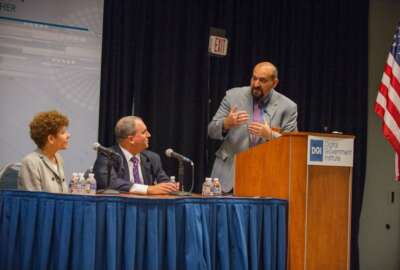
NSF joins a growing list of agencies reconfiguring its CIO’s office
National Science Foundation CIO Dorothy Aronson will remain a principal advisor while a new executive will lead the Office of Business Information Technology (BIT)...
The role of the agency chief information officer is undergoing yet another evolutionary step.
The National Science Foundation is joining a small but growing number of agencies remaking their CIO’s office.
The agency is planning on establishing a new Office of Business Information Technology (BIT) Services that will be led by an executive who will be both the CIO and chief technology officer.
A NSF spokesperson said current CIO Dorothy Aronson will remain a principal advisor to the agency’s director and other senior management on all matters involving information technology, but will no long hold the title of CIO.
“Information technology, technology innovation, and data are critical to NSF’s mission. These business areas are especially critical as we anticipate significant growth from the CHIPS and Science Act. NSF is expanding quickly and needs to position itself with the right structure and resources so we can continue to provide outstanding information technology services to our staff and the external research community,” the spokesperson said in an email to Federal News Network.
Aronson has been the NSF CIO since December 2017, where she has led the agency on an IT modernization journey, building governance and customer experience structures and also addressing underlying infrastructure issues.
Three roles into one
NSF released a job announcement for the new combined position on Jan. 24 with applications being due on Feb. 27.
In the opening, NSF describes the new head of BIT as someone who will establish “strategic direction and has overall responsibility on matters involving leadership and direction in the formulation, development and execution of NSF’s IT management program. The incumbent ensures the agency maximizes the use of technology, information and data systems to improve agency mission delivery and performance and provides regular reports to the Office of the Director. The incumbent is also responsible for formulating and articulating the agency’s policy, position or response on current or emerging information technology and its relationship to the NSF and its mission.”
NSF also describes the CIO and CTO roles that align with what a typical position description would entail.
The spokesperson said the Office of Business Information Technology Services came from recommendations made by several groups, including the Evidence and Data Governance Steering Committee and the Business and Operations Advisory Committee subcommittee.
The evidence and data committee recently submitted a proposal for centralized data analytics, and it makes sense to have an integrated IT and data management strategy under one organization.
The business and operations subcommittee recommended NSF review the current IT operational structures for leadership, governance, delivery, operations and oversight to identify opportunities to further streamline the processes or realignment of responsibilities of the CIO’s office. The subcommittee said this will improve the overall visibility, effectiveness and create closer linkages of organizational capability with business objectives.
“Since the individual responsible for strategic IT direction, NSF’s CIO and the individuals responsible for the implementation of technical capabilities and day-to-day operations are in different parts of the organization, ensure that processes defined support maintaining alignment between strategic goals and project and operational activities,” the report stated.
Long history of boosting CIOs
NSF’s decision follows a similar one by the National Institutes of Health earlier this month. NIH decided to separate its CIO from the director of the Center for Information Technology and create two distinct positions after almost 25 years of combining the roles.
And if you add to those two internal changes the push by Congress in the 2023 omnibus bill to ensure CIOs at certain agencies have more authority, it’s easy to see how this evolution is slowly happening.
Both the NSF and NIH decisions to reconfigure their CIO and technology oversight offices are the latest step in this 25-plus year evolution of the agency’s lead technology role.
Beginning in 1996 with the Clinger-Cohen Act, Congress established agency CIO positions with designated roles and responsibilities for the first time in law. Lawmakers continued to build up the positions with the E-Government Act of 2002 and the creation of the Office of E-Government and IT in the Office of Management and Budget, giving agency CIOs White House level leadership.
A third law, the 2014 Federal IT Acquisition and Reform Act (FITARA), further enhanced CIOs’ authorities and responsibilities.
In between each of those points in time in law, cyber and data breaches, assorted OMB policies and presidential executive orders — the most recent coming in 2018 — have tried to push these positions further into the executive suite.
The pandemic is the latest forcing function to drive change in how CIOs are viewed, respected and included, given the “discovery” of how important technology, networks and data became to meet agency mission needs.
Public vs. private CIOs
But what’s different here is NSF isn’t just hiring a CIO or CTO, but someone with a broader range of skillsets, a person that looks more like a private sector CIO than a typical person who may work in the public sector.
A September 2022 report from the Government Accountability Office looking at the similarities and differences between private sector and public sector CIOs further shows how change is coming to the role. GAO surveyed private sector CIOs and held a panel discussion with former federal agency CIOs.
What they found helps put a finer point on this continued evolution.
For instance, GAO reported private sector CIOs say a critical factor for a CIO’s success is an ability to bridge gaps between the technical and business parts of the company and promote two-way information exchange.
“Private sector panelists also stated that the concept of shared accountability was a key part of their business culture. Participants also viewed collaboration between the CIO and other business-centric senior executives as essential, and stated that cross-functional teams often must work together to drive business outcomes, such as increasing revenue and customer satisfaction,” the report found.
The changes NSF is ushering in jives with what GAO’s report highlighted. Both private and federal CIOs discussed the importance of having IT knowledge, but stressed the importance of having business knowledge and experience.
“The high portion of CIOs with company or industry knowledge or previous CIO experience was explained by expert panel CIOs, who stated that communication and project management skills, as well as knowledge of the business of their organization, were more central to their success,” the report stated. “[I]n order to better ensure that CIOs are able to align IT to the organization’s business goals, panelists stated that it was important for CIO candidates to have an understanding of their organization or industry. The current federal CIO also stated that managerial skills were key to the success of federal CIOs. Managerial skills mentioned by the federal CIO included a detailed understanding of both IT and non-IT aspects of the organization’s mission, an ability to communicate the relevancy of IT initiatives to other leaders, and an ability to build relationships and create partnerships.”
Finally, another key point that drives this point home from the GAO survey came around shared accountability vs. shared responsibility as part of the business culture.
Like what NSF seems to be trying to do, the private sector CIOs said cross-functional teams often work together to drive business outcomes, such as increasing revenue and customer satisfaction.
For example, one private sector CIO stated, “To me, a CIO today is really that individual that can sit at the table and really advise the business or advise the mission organizations around the strategic use of technology and information and help them to do better.”
Another private sector CIO stated, “We are involved in virtually everything that goes on inside the company, one way or the other.”
Between the technology enlightenment that occurred during the pandemic and ubiquitous nature of data, systems and software in almost everything the government does from border security to food inspections to buying pens and pencils, this next evolution in the role of the agency CIO seems about ready to take off, and most agree, none too soon.
Copyright © 2025 Federal News Network. All rights reserved. This website is not intended for users located within the European Economic Area.
Jason Miller is executive editor of Federal News Network and directs news coverage on the people, policy and programs of the federal government.
Follow @jmillerWFED





